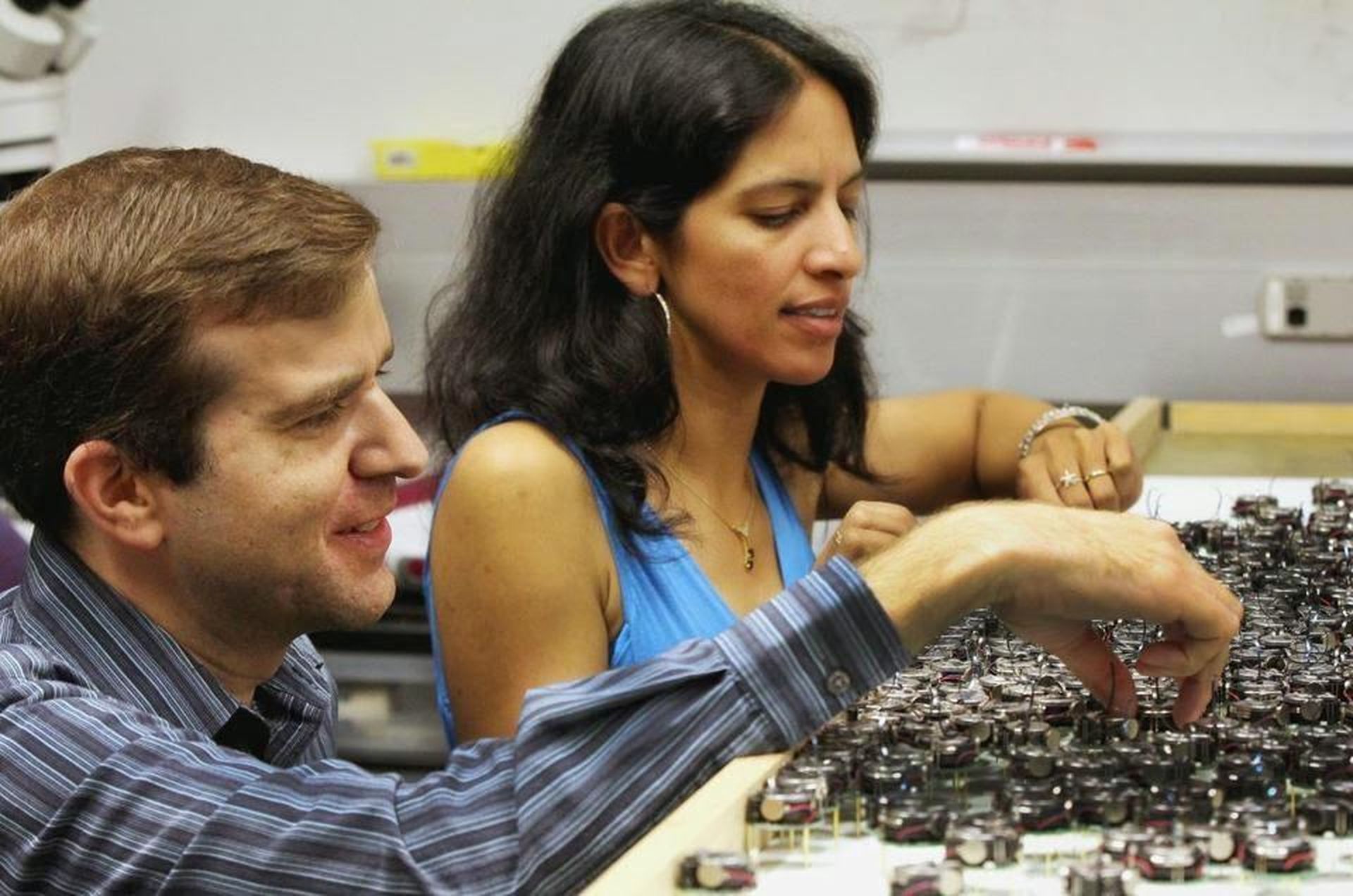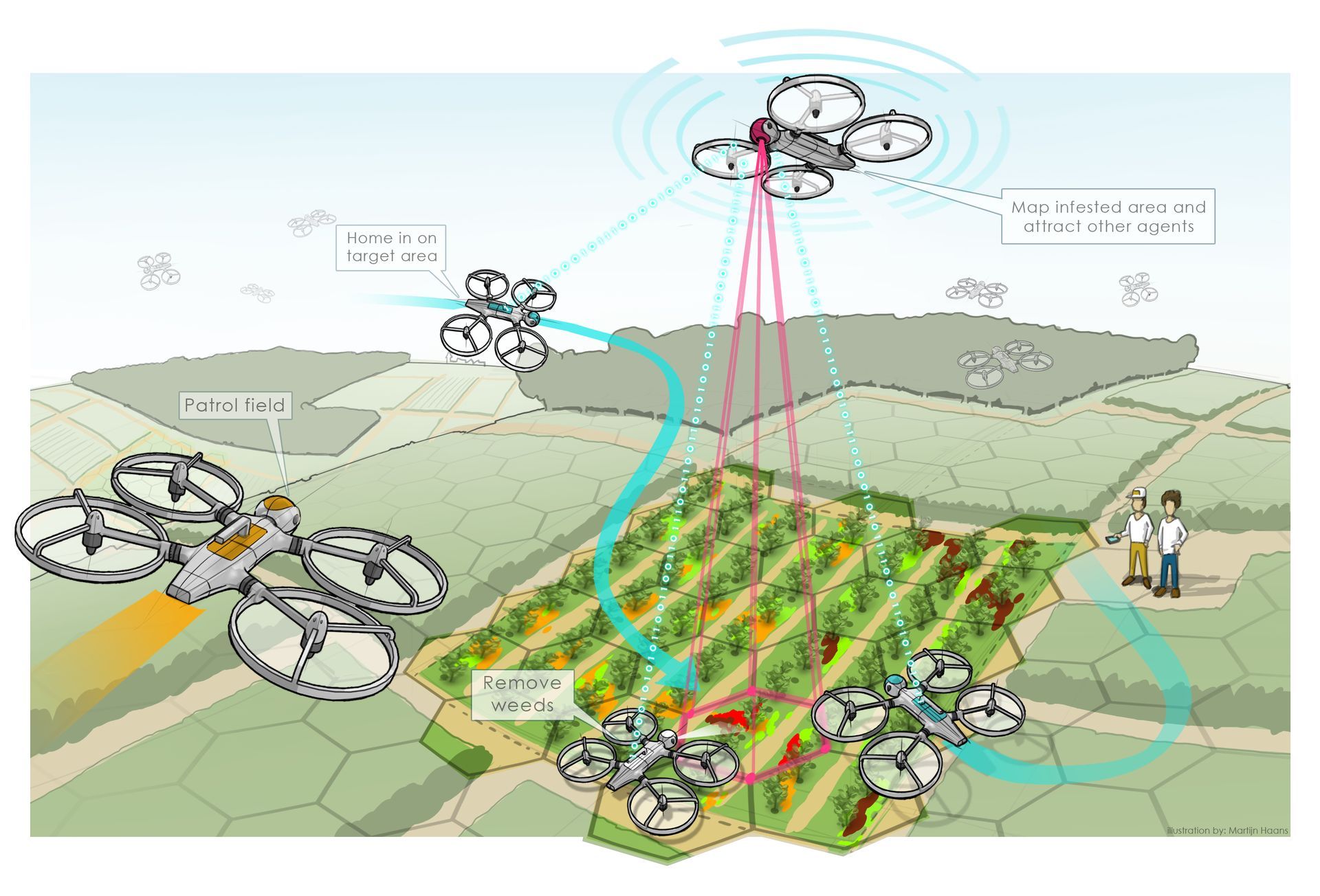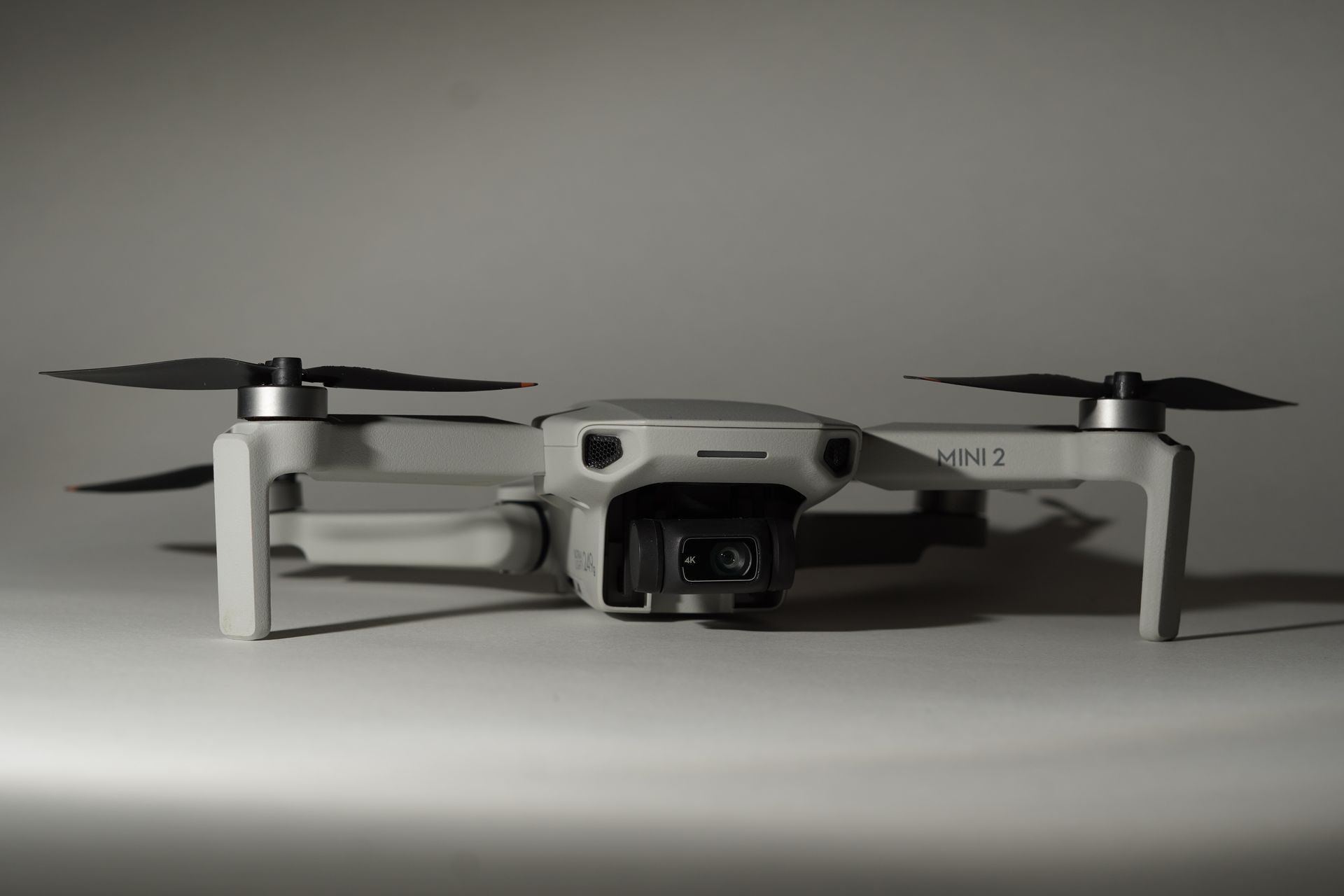Swarm robotics, a field inspired by the remarkable collective behaviors observed in nature, seeks to study and apply the concept of swarm behavior to a diverse range of robotic systems. Just like witnessing a flock of birds soaring through the sky or a school of fish effortlessly navigating underwater, swarm behavior exemplifies the ability of individual agents to interact and coordinate, resulting in mesmerizing collective actions.
While commonly observed in the natural world, the principles of swarm behavior have captured the attention of researchers and engineers who aim to replicate and harness its power within the realm of robotics.
The essence of swarm behavior lies in the emergent properties that arise from the interaction of autonomous individual agents, each possessing relatively simple rules or behaviors. These agents can be robots, drones, or even virtual entities, and they collectively work towards achieving a common goal or solving complex tasks through distributed coordination.
By using the power of collaboration and self-organization, swarm robotics aims to create systems that exhibit scalability, robustness, adaptability, and efficiency.
What is swarm robotics?
Swarm robotics is a field of robotics that deals with the design, control, and coordination of large groups of robots. Swarm robots are typically simple and inexpensive, but they can achieve complex tasks by working together. Swarm robotics is inspired by the behavior of social insects, such as ants and bees, which are able to accomplish complex tasks such as foraging and building nests without any centralized control.
Social insects are insects that live in colonies, and they exhibit a wide range of cooperative behaviors. These behaviors are often complex and coordinated, and they allow social insects to achieve tasks that would be impossible for individual insects.

Social insects exhibit remarkable abilities in various aspects of their collective behavior. One notable behavior is foraging, where they collaborate harmoniously to locate sustenance and return it to their colony. The process involves intricate tasks like scouring the surroundings for food sources, intercommunicating vital information among colony members, and efficiently transporting the acquired nourishment back to the nest.
Another captivating behavior observed in social insects is their collaborative nest-building endeavor. With concerted effort, they gather essential materials, construct elaborate structures, and fiercely protect the nest from potential predators. This collaborative construction showcases their collective problem-solving abilities and showcases their cooperative nature.
Swarm robotics draws inspiration from the collective behaviors observed in social insects. By emulating their collaborative strategies, swarm robotics aims to develop multi-robot systems that can work together cohesively to solve complex tasks. The principles of foraging, nest building, antennation, division of labor, and mimicry observed in social insects serve as valuable models for designing efficient and adaptive robotic swarms. Through the integration of these concepts, swarm robotics endeavors to unlock new possibilities in areas such as search and rescue missions, environmental monitoring, and industrial automation.
Kilobots that can get a ton of work done
One prominent example of swarm robots that has garnered significant attention in the field of swarm robotics is the Kilobots. Developed by the Self-Organizing Systems Research Group at Harvard University, Kilobots are a remarkable swarm robot platform that has been instrumental in advancing swarm robotics research.
The Kilobots are miniature, low-cost robots equipped with simple sensors and actuators. They are designed to operate in large swarms, consisting of hundreds or even thousands of robots. These tiny robots measure just a few centimeters in diameter and are characterized by their cylindrical shape and three omnidirectional legs.
What makes the Kilobots particularly noteworthy is their ability to communicate and coordinate their actions with one another, despite their limited individual capabilities. They employ infrared communication to exchange information and make decisions as a collective entity. This communication allows Kilobots to perform complex tasks through emergent behaviors, where the combined actions of the swarm lead to the desired outcome.
Unlocking the full potential of automation with smart robotics
The Kilobots have become a popular tool for researchers in swarm robotics due to their scalability, simplicity, and affordability. They enable investigations into various swarm behaviors, including aggregation, pattern formation, collective transport, and decision making. The Kilobot platform provides researchers with a practical means to study and experiment with swarm robotics algorithms and concepts.
With their widespread adoption and use in research laboratories around the world, Kilobots have become an iconic symbol of swarm robotics.
The science behind Swarm Robotics
The science behind swarm robotics is based on the principles of swarm intelligence. Swarm intelligence is a type of artificial intelligence that is inspired by the behavior of social insects.
Swarm intelligence algorithms are typically decentralized, meaning that they do not require a central controller. Instead, the robots in a swarm communicate with each other and coordinate their actions locally.
According to the ”Swarm Robotic Behaviors and Current Applications” article, swarm behavior can be divided into four different sub-topics:
- Spatial organization
- Navigation
- Decision making
- Miscellaneous

Spatial organization
Swarm robotics encompasses a range of behaviors that enable coordinated movement and spatial organization of robot swarms in their environment. These behaviors contribute to efficient interaction and manipulation of objects within the swarm.
One such behavior is aggregation, which involves bringing individual robots together spatially within a specific region of the environment. Aggregation facilitates closer proximity among swarm members, enabling enhanced interaction and cooperation among them.
Pattern formation is another behavior wherein the swarm of robots organizes itself into a predetermined shape. This can include formations like chain structures, which establish communication links between different points within the swarm.
Self-assembly is a behavior that involves connecting individual robots to form structures, either physically or through communication links. This behavior can be particularly useful in achieving predefined shapes or structures within the swarm, a concept known as morphogenesis.
Object clustering and assembly is a behavior that allows the swarm of robots to manipulate objects distributed in the environment. By clustering and assembling these objects, the swarm can engage in construction processes or accomplish specific tasks that require collaborative object manipulation.
Navigation
Navigation behaviors in swarm robotics focus on the coordinated movement of the robot swarm within their environment, enabling exploration, motion in formation, and object transport.
Collective exploration involves cooperative navigation of the swarm through the environment, facilitating tasks such as situational overview, object search, environmental monitoring, or establishing communication networks.
Coordinated motion behavior guides the swarm of robots to move together in a specific formation. This formation can take a well-defined shape, like a line, or be more arbitrary, as observed in flocking behavior.
Collective transport allows the swarm of robots to collectively move objects that may be too heavy or large for individual robots to handle alone. By coordinating their efforts, the swarm can achieve effective object transportation.
Collective localization enables robots within the swarm to determine their position and orientation relative to each other by establishing a local coordinate system. This behavior facilitates efficient coordination and communication among swarm members.

Decision making
Decision-making behaviors enable the robots in a swarm to make collective choices and allocate tasks efficiently.
Consensus behavior allows individual robots in the swarm to converge on a single common choice from several alternatives, ensuring coherence and unity within the group.
Task allocation behavior dynamically assigns arising tasks to individual robots based on their capabilities, maximizing the overall performance of the swarm. This behavior becomes particularly valuable when the robots in the swarm possess heterogeneous capabilities.
Collective fault detection identifies individual robots that deviate from the desired behavior of the swarm, often due to hardware failures or deficiencies. This behavior allows for early detection and mitigation of faults within the collective system.
Collective perception involves combining locally sensed data from individual robots into a comprehensive understanding of the environment. This behavior allows the swarm to make informed collective decisions, such as reliable object classification or determining optimal solutions to global problems.
Synchronization behavior aligns the frequency and phase of oscillators among the robots in the swarm, enabling them to act synchronously. This shared understanding of time enhances coordination and cooperation within the swarm.
Group size regulation allows the robots in the swarm to form groups of desired sizes. If the swarm exceeds the desired group size, it can autonomously split into multiple groups, promoting efficient organization and scalability.
Miscellaneous
Additional behaviors in swarm robotics do not fit into the previous categories but remain integral to the field.
Self-healing behavior allows the swarm to recover from faults caused by individual robot deficiencies. By minimizing the impact of robot failures, self-healing enhances the reliability, robustness, and overall performance of the swarm.
Self-reproduction behavior enables the swarm to create new robots or replicate patterns formed by multiple individuals. This behavior aims to increase the autonomy of the swarm, reducing reliance on human intervention for the creation of new robots.
Human-swarm interaction behavior allows humans to control or receive information from the robots in the swarm. This interaction can occur remotely through computer terminals or in a shared environment through visual or acoustic clues, facilitating collaboration between humans and the swarm.
These behaviors in swarm robotics collectively contribute to the development of adaptive and efficient systems that draw inspiration from the collective intelligence and organization observed in social insects.

Key applications of swarm robotics
Swarm robotics is an extraordinary field brimming with possibilities, set to transform numerous industries through its remarkable applications. Some of the key applications of swarm robotics include:
- Search and rescue: Swarm robots could be used to search for survivors in disaster areas.
In 2015, a swarm of robots was used to search for survivors after the Nepal earthquake. The robots were able to cover a wider area than traditional search teams and they were able to reach areas that were difficult for humans to access.
- Environmental monitoring: Swarm robots could be used to monitor environmental conditions, such as air quality or water pollution
For example, in 2016, a swarm of robots was used to monitor air quality in Beijing. The robots were able to collect data in real time and they were able to identify areas with high levels of pollution.
- Agriculture: Swarm robots could be used to plant crops, harvest crops, or control pests
Back in 2017, a swarm of robots was used to plant rice in China by SAGA. The robots were able to plant the rice more quickly and efficiently than human workers.
- Construction: Swarm robots could be used to build structures, such as bridges or buildings
In 2018, a swarm of robots was used to build a small bridge in Japan. The robots were able to build the bridge in a fraction of the time it would have taken human workers
- Defense: Swarm robots could be used to patrol borders or detect and disarm landmines
In 2019, a swarm of robots was used to patrol the border between the United States and Mexico. The robots were able to detect and track illegal immigrants
Challenges and opportunities in swarm robotics
Swarm robotics presents a multitude of challenges and opportunities that shape its future development. Overcoming these challenges and leveraging the opportunities can lead to significant advancements in the field. Some of the challenges in swarm robotics include:
Developing effective communication and coordination algorithms: Swarm robots must have efficient means of communication and coordination to work together seamlessly. Designing algorithms that allow for reliable information exchange and coordinated actions among the individual agents is crucial for the success of swarm systems.
Designing robust and reliable swarm robots: Swarm robots need to be capable of operating in diverse environments and conditions, including harsh or unpredictable ones. Ensuring the durability, robustness, and adaptability of individual robots is essential to the overall effectiveness and longevity of swarm systems.
Addressing the “swarm effect”: The swarm effect refers to the potential chaos or unpredictable behavior that can arise if the swarm is not properly coordinated. Mitigating the swarm effect requires developing control strategies and algorithms that ensure cohesive and organized behavior within the swarm, even when faced with complex and dynamic situations.
Despite these challenges, swarm robotics offers numerous opportunities that can drive innovation and revolutionize the robotics field. Some of these opportunities include:
The potential for low-cost, mass-produced swarm robots: Swarm robots can be designed to be cost-effective and easily manufacturable, enabling mass production. This affordability could make swarm robotics more accessible to a wider range of users, facilitating the adoption of swarm systems in various industries and applications.

The potential for swarm robots to tackle difficult or impossible tasks: Swarm robots can be employed in scenarios that are deemed too dangerous, complex, or inaccessible for traditional robots. Their collective intelligence and cooperation allow them to perform tasks that would otherwise be challenging or infeasible, opening new avenues for exploration and problem-solving.
The potential for swarm robots to exhibit advanced intelligence: Swarm systems have the capacity to exhibit emergent behaviors and collective intelligence that surpass the capabilities of individual robots. Through learning, adaptation, and self-organization, swarm robots can dynamically respond to their environment, making them capable of solving complex problems and optimizing their performance.
These opportunities in swarm robotics provide fertile ground for advancements in various industries, including logistics, agriculture, surveillance, and disaster response. As research progresses, swarm robotics has the potential to reshape the way robots interact with and navigate through the world, leading to innovative and intelligent systems that can tackle real-world challenges with unprecedented efficiency and adaptability.
Swarm robotics vs. traditional robotics
Swarm robotics, although a relatively new field, holds great potential for revolutionizing various industries. In comparison to traditional robotics, which has already established itself, swarm robotics offers distinct advantages that make it particularly well-suited for certain tasks. Traditional robots are often costly, intricate, and less effective when it comes to cooperative and coordinated efforts.
One notable advantage of swarm robotics is its scalability. This means that it can easily accommodate a large number of robots without significantly increasing the complexity of the system.
Robustness is another key advantage of swarm robotics. In this context, robustness refers to the ability of the system to withstand the failure of individual robots. If one robot within a swarm malfunctions or is disabled, the remaining robots can continue working cooperatively to accomplish the task at hand. This robustness is particularly valuable in tasks performed in hazardous or unpredictable environments, where individual robot failures are more likely to occur.
Additionally, swarm robotics offers a high degree of adaptability. Swarm robots are typically designed to be simple and cost-effective, making them easy to reprogram for different tasks. This adaptability allows swarm robotics to excel in situations that demand flexibility and versatility. Whether it involves changes in task requirements or the need to tackle diverse challenges, swarm robotics can quickly adapt to varying circumstances.
Swarm Robotics in popular culture
Swarm robotics has been featured in a number of popular culture works, including the movies “Starship Troopers” and “The Matrix“. Even though they’ve covered the bad and scary sides of swarm robotics, these works have helped to raise awareness of the potential of swarm robotics, and they have inspired a new generation of researchers to explore this exciting field.
Swarm robotics research is still in its early stages, with limited successful transitions to industrial applications and daily use. However, significant progress has been made. While swarm robotics faces challenges in its integration into industrial settings, there is a promise for the development of advanced applications in sectors like logistics, agriculture, and inspection. Ongoing research and advancements in swarm robotics platforms offer opportunities for adaptability, robustness, and scalability, leading to a greater understanding and utilization of swarm behaviors in the future.
Featured image credit: Photo by Michael Dolejš on Unsplash.





